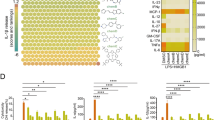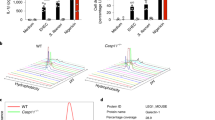Abstract
A systemic inflammatory response is observed in patients undergoing hemorrhagic shock and sepsis. Here we report increased levels of cold-inducible RNA-binding protein (CIRP) in the blood of individuals admitted to the surgical intensive care unit with hemorrhagic shock. In animal models of hemorrhage and sepsis, CIRP is upregulated in the heart and liver and released into the circulation. In macrophages under hypoxic stress, CIRP translocates from the nucleus to the cytosol and is released. Recombinant CIRP stimulates the release of tumor necrosis factor-α (TNF-α) and HMGB1 from macrophages and induces inflammatory responses and causes tissue injury when injected in vivo. Hemorrhage-induced TNF-α and HMGB1 release and lethality were reduced in CIRP-deficient mice. Blockade of CIRP using antisera to CIRP attenuated inflammatory cytokine release and mortality after hemorrhage and sepsis. The activity of extracellular CIRP is mediated through the Toll-like receptor 4 (TLR4)–myeloid differentiation factor 2 (MD2) complex. Surface plasmon resonance analysis indicated that CIRP binds to the TLR4-MD2 complex, as well as to TLR4 and MD2 individually. In particular, human CIRP amino acid residues 106–125 bind to MD2 with high affinity. Thus, CIRP is a damage-associated molecular pattern molecule that promotes inflammatory responses in shock and sepsis.
This is a preview of subscription content, access via your institution
Access options
Subscribe to this journal
Receive 12 print issues and online access
$209.00 per year
only $17.42 per issue
Buy this article
- Purchase on Springer Link
- Instant access to full article PDF
Prices may be subject to local taxes which are calculated during checkout





Similar content being viewed by others
References
Holcomb, J.B. et al. Challenges to effective research in acute trauma resuscitation: consent and endpoints. Shock 35, 107–113 (2011).
Bulger, E.M. et al. Hypertonic resuscitation of hypovolemic shock after blunt trauma: a randomized controlled trial. Arch. Surg. 143, 139–148 (2008).
Kaczorowski, D.J., Mollen, K.P., Edmonds, R. & Billiar, T.R. Early events in the recognition of danger signals after tissue injury. J. Leukoc. Biol. 83, 546–552 (2008).
Dombrovskiy, V.Y., Martin, A.A., Sunderram, J. & Paz, H.L. Rapid increase in hospitalization and mortality rates for severe sepsis in the United States: a trend analysis from 1993 to 2003. Crit. Care Med. 35, 1244–1250 (2007).
Ward, P.A. New approaches to the study of sepsis. EMBO Mol. Med. 4, 1234–1243 (2012).
Medzhitov, R. Origin and physiological roles of inflammation. Nature 454, 428–435 (2008).
Oppenheim, J.J. & Yang, D. Alarmins: chemotactic activators of immune responses. Curr. Opin. Immunol. 17, 359–365 (2005).
Zhang, X. & Mosser, D.M. Macrophage activation by endogenous danger signals. J. Pathol. 214, 161–178 (2008).
Beutler, B.A. TLRs and innate immunity. Blood 113, 1399–1407 (2009).
Ward, P.A. The sepsis seesaw: seeking a heart salve. Nat. Med. 15, 497–498 (2009).
Kawai, T. & Akira, S. The role of pattern-recognition receptors in innate immunity: update on Toll-like receptors. Nat. Immunol. 11, 373–384 (2010).
Chen, G.Y., Tang, J., Zheng, P. & Liu, Y. CD24 and Siglec-10 selectively repress tissue damage–induced immune responses. Science 323, 1722–1725 (2009).
Wang, H. et al. HMG-1 as a late mediator of endotoxin lethality in mice. Science 285, 248–251 (1999).
Tsung, A. et al. The nuclear factor HMGB1 mediates hepatic injury after murine liver ischemia-reperfusion. J. Exp. Med. 201, 1135–1143 (2005).
Quintana, F.J. & Cohen, I.R. Heat shock proteins as endogenous adjuvants in sterile and septic inflammation. J. Immunol. 175, 2777–2782 (2005).
Martinon, F., Pétrilli, V., Mayor, A., Tardivel, A. & Tschopp, J. Gout-associated uric acid crystals activate the NALP3 inflammasome. Nature 440, 237–241 (2006).
Vogl, T. et al. Mrp8 and Mrp14 are endogenous activators of Toll-like receptor 4, promoting lethal, endotoxin-induced shock. Nat. Med. 13, 1042–1049 (2007).
Xu, J. et al. Extracellular histones are major mediators of death in sepsis. Nat. Med. 15, 1318–1321 (2009).
Zhang, Q. et al. Circulating mitochondrial DAMPs cause inflammatory responses to injury. Nature 464, 104–107 (2010).
Nishiyama, H. et al. Cloning and characterization of human CIRP (cold-inducible RNA-binding protein) cDNA and chromosomal assignment of the gene. Gene 204, 115–120 (1997).
Nishiyama, H. et al. A glycine-rich RNA-binding protein mediating cold-inducible suppression of mammalian cell growth. J. Cell Biol. 137, 899–908 (1997).
Xue, J.H. et al. Effects of ischemia and H2O2 on the cold stress protein CIRP expression in rat neuronal cells. Free Radic. Biol. Med. 27, 1238–1244 (1999).
Nishiyama, H. et al. Decreased expression of cold-inducible RNA-binding protein (CIRP) in male germ cells at elevated temperature. Am. J. Pathol. 152, 289–296 (1998).
Nishiyama, H. et al. Diurnal change of the cold-inducible RNA-binding protein (Cirp) expression in mouse brain. Biochem. Biophys. Res. Commun. 245, 534–538 (1998).
Sheikh, M.S. et al. Identification of several human homologs of hamster DNA damage–inducible transcripts. Cloning and characterization of a novel UV-inducible cDNA that codes for a putative RNA-binding protein. J. Biol. Chem. 272, 26720–26726 (1997).
Wellmann, S. et al. Oxygen-regulated expression of the RNA-binding proteins RBM3 and CIRP by a HIF-1–independent mechanism. J. Cell Sci. 117, 1785–1794 (2004).
Qu, Y. & Dubyak, G.R. P2X7 receptors regulate multiple types of membrane trafficking responses and non-classical secretion pathways. Purinergic Signal. 5, 163–173 (2009).
Aida, Y. & Pabst, M.J. Removal of endotoxin from protein solutions by phase separation using Triton X-114. J. Immunol. Methods 132, 191–195 (1990).
Wang, Y. et al. Identification of stimulating and inhibitory epitopes within the heat shock protein 70 molecule that modulate cytokine production and maturation of dendritic cells. J. Immunol. 174, 3306–3316 (2005).
Henderson, B. et al. Caught with their PAMPs down? The extracellular signalling actions of molecular chaperones are not due to microbial contaminants. Cell Stress Chaperones 15, 123–141 (2010).
Andersson, U. et al. High mobility group 1 protein (HMG-1) stimulates proinflammatory cytokine synthesis in human monocytes. J. Exp. Med. 192, 565–570 (2000).
Yang, H. et al. Reversing established sepsis with antagonists of endogenous high-mobility group box 1. Proc. Natl. Acad. Sci. USA 101, 296–301 (2004).
Yang, S., Zhou, M., Chaudry, I.H. & Wang, P. Novel approach to prevent the transition from the hyperdynamic phase to the hypodynamic phase of sepsis: role of adrenomedullin and adrenomedullin binding protein-1. Ann. Surg. 236, 625–633 (2002).
Nagai, Y. et al. Essential role of MD-2 in LPS responsiveness and TLR4 distribution. Nat. Immunol. 3, 667–672 (2002).
Hyakushima, N. et al. Interaction of soluble form of recombinant extracellular TLR4 domain with MD-2 enables lipopolysaccharide binding and attenuates TLR4-mediated signaling. J. Immunol. 173, 6949–6954 (2004).
Yang, C. & Carrier, F. The UV-inducible RNA-binding protein A18 (A18 hnRNP) plays a protective role in the genotoxic stress response. J. Biol. Chem. 276, 47277–47284 (2001).
Cammas, A., Lewis, S.M., Vagner, S. & Holcik, M. Post-transcriptional control of gene expression through subcellular relocalization of mRNA binding proteins. Biochem. Pharmacol. 76, 1395–1403 (2008).
De Leeuw, F. et al. The cold-inducible RNA-binding protein migrates from the nucleus to cytoplasmic stress granules by a methylation-dependent mechanism and acts as a translational repressor. Exp. Cell Res. 313, 4130–4144 (2007).
Yang, R. et al. Functional significance for a heterogenous ribonucleoprotein A18 signature RNA motif in the 3′-untranslated region of ataxia telangiectasia mutated and Rad3-related (ATR) transcript. J. Biol. Chem. 285, 8887–8893 (2010).
Qu, Y., Franchi, L., Nunez, G. & Dubyak, G.R. Nonclassical IL-1β secretion stimulated by P2X7 receptors is dependent on inflammasome activation and correlated with exosome release in murine macrophages. J. Immunol. 179, 1913–1925 (2007).
Benhamou, Y. et al. Toll-like receptors 4 contribute to endothelial injury and inflammation in hemorrhagic shock in mice. Crit. Care Med. 37, 1724–1728 (2009).
Wittebole, X., Castanares-Zapatero, D. & Laterre, P.F. Toll-like receptor 4 modulation as a strategy to treat sepsis. Mediators Inflamm. 2010, 568396 (2010).
Park, J.S. et al. Involvement of toll-like receptors 2 and 4 in cellular activation by high mobility group box 1 protein. J. Biol. Chem. 279, 7370–7377 (2004).
Ohashi, K., Burkart, V., Flohé, S. & Kolb, H. Cutting edge: heat shock protein 60 is a putative endogenous ligand of the toll-like receptor-4 complex. J. Immunol. 164, 558–561 (2000).
Termeer, C. et al. Oligosaccharides of Hyaluronan activate dendritic cells via toll-like receptor 4. J. Exp. Med. 195, 99–111 (2002).
Okamura, Y. et al. The extra domain A of fibronectin activates Toll-like receptor 4. J. Biol. Chem. 276, 10229–10233 (2001).
Yang, H. et al. A critical cysteine is required for HMGB1 binding to Toll-like receptor 4 and activation of macrophage cytokine release. Proc. Natl. Acad. Sci. USA 107, 11942–11947 (2010).
Yang, H., Antoine, D.J., Andersson, U. & Tracey, K.J. The many faces of HMGB1: molecular structure-functional activity in inflammation, apoptosis, and chemotaxis. J. Leukoc. Biol. 93, 865–873 (2013).
Shin, H.J. et al. Kinetics of binding of LPS to recombinant CD14, TLR4, and MD-2 proteins. Mol. Cells 24, 119–124 (2007).
Scaffidi, P., Misteli, T. & Bianchi, M.E. Release of chromatin protein HMGB1 by necrotic cells triggers inflammation. Nature 418, 191–195 (2002).
Brochu, C. et al. NF-κB–dependent role for cold-inducible RNA binding protein in regulating interleukin 1β. PLoS ONE 8, e57426 (2013).
Sakurai, T. et al. Cirp protects against tumor necrosis factor-α–induced apoptosis via activation of extracellular signal-regulated kinase. Biochim. Biophys. Acta 1763, 290–295 (2006).
Wu, R. et al. Mechanisms responsible for vascular hyporesponsiveness to adrenomedullin after hemorrhage: the central role of adrenomedullin binding protein-1. Ann. Surg. 242, 115–123 (2005).
Miksa, M. et al. Immature dendritic cell–derived exosomes rescue septic animals via milk fat globule epidermal growth factor-factor VIII. J. Immunol. 183, 5983–5990 (2009).
Acknowledgements
This work was supported by US National Institutes of Health (NIH) grants HL076179 and GM053008 (P.W.). We thank H. Erlandsson-Harris (Karolinska Institute) for providing Ager−/−, Tlr2−/− and Tlr4−/− mice, M. Hu, J.H. Li and L.M. Corbo for technical assistance, L. Caracappa for editorial assistance and Y. Al-Abed and A. Ragab for assistance with SPR analysis. The BIAcore instrument was supported by NIH grant S10OD012042. J.F. was partly supported by the Smoking Research Foundation of Japan.
Author information
Authors and Affiliations
Contributions
X.Q. and M.Z. performed the experiments and analyzed data. W.-L.Y. conducted the translocation study, designed and coordinated SPR analysis and wrote the manuscript. R.W. designed the experiments. A.J. assisted with the design of experiments and participated in manuscript editing. W.D. and Y.J. performed animal studies. M.K. collected the serum from patients admitted to the surgical ICU and analyzed human data. J.N. and G.F.C. analyzed animal studies. H.Y. and K.J.T. assisted in the knockout mice study and SPR analysis. J.F. assisted in the CIRP knockout mice and GFP-CIRP study and revised the manuscript. H.W. assisted with the design of the study and analyzed data. P.W. designed and supervised the study and revised the manuscript.
Corresponding author
Ethics declarations
Competing interests
P.W. is an inventor of the pending PCT application WO 2010/120726 A1 entitled “Treatment of inflammatory diseases by inhibiting cold-inducible RNA-binding protein (CIRP).” This patent application covers the fundamental concept of using CIRP inhibitors for the treatment of inflammatory diseases.
Supplementary information
Supplementary Text and Figures
Supplementary Figures 1-6 and Supplementary Table 1 (PDF 585 kb)
Source data
Rights and permissions
About this article
Cite this article
Qiang, X., Yang, WL., Wu, R. et al. Cold-inducible RNA-binding protein (CIRP) triggers inflammatory responses in hemorrhagic shock and sepsis. Nat Med 19, 1489–1495 (2013). https://doi.org/10.1038/nm.3368
Received:
Accepted:
Published:
Issue Date:
DOI: https://doi.org/10.1038/nm.3368
This article is cited by
-
Triggering receptor expressed on myeloid cells-1 in sepsis, and current insights into clinical studies
Critical Care (2024)
-
Musashi-2 potentiates colorectal cancer immune infiltration by regulating the post-translational modifications of HMGB1 to promote DCs maturation and migration
Cell Communication and Signaling (2024)
-
CIRP attenuates acute kidney injury after hypothermic cardiovascular surgery by inhibiting PHD3/HIF-1α-mediated ROS-TGF-β1/p38 MAPK activation and mitochondrial apoptotic pathways
Molecular Medicine (2023)
-
An engineered miRNA PS-OMe miR130 inhibits acute lung injury by targeting eCIRP in sepsis
Molecular Medicine (2023)
-
Activation of immune signals during organ transplantation
Signal Transduction and Targeted Therapy (2023)



